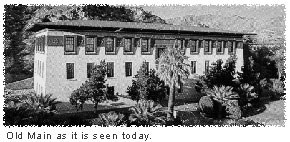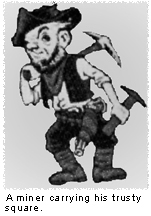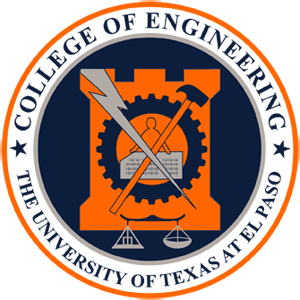History
Humble Beginnings
When the Texas State School of Mines and Metallurgy was established on April 16, 1913, with the signing of Senate Bill 183 by Governor O. B. Colquitt, a huge need in the mining industry had finally been filled. With 27 students enrolled, the school´s first term commenced in September 28, 1914. Boasting a modest three buildings on 22 acres at the site of the defunct El Paso Military Institute east of Fort Bliss, the purchase of the location with $50,000 in pledges from businesses and individuals began a long, close relationship between the school and the community.

The college has gone through many changes since the first students passed through the doors of the School of Mines. In October 1916, a fire destroyed the Main Building of the original campus forcing classes into the bottom floor of the dormitory and a sheet-iron building that served as the chemistry lab. This mishap, combined with the school´s growth and Fort Bliss´ military buildup due to the Mexican Revolution and World War I made relocation a priority.
The search for a new location lead to the present site in the western foothills of the Franklin Mountains, which was convenient to both downtown El Paso and the American Smelting and Refining Company (ASARCO). To pay for the new campus, the school´s first dean, Stephen Howard Worrell, secured $100,000 from the state legislature. As before, civic leaders from El Paso assisted in the acquisition of the property.
Castles in the Air
Dean Worrell´s wife, Kathleen, played a key role in what was to become the school´s signature architecture. Mrs. Worrell, while studying the April 1914 issue of National Geographic, noted the striking similarities between the rugged landscape of the Asian Kingdom of Bhutan and the new campus location. The article, entitled ”Castles in the Air“, featured photographs of buildings with high sloping walls, deep inset windows, red brick friezes, mandalas, and majestic overhangs. Though they required some persuading, Mrs. Worrell eventually convinced officials to use the architecture of the small Himalayan nation as a model for the buildings of the new campus.
By January 1918, the new buildings were completed and ready for classes, in time for the school to join the University of Texas system a year later as the University of Texas Department of Mines and Metallurgy. The distinctive architecture would forever make the school unique among universities of the western hemisphere. Today, the original four buildings are still in use: Old Main, Burges Hall, Quinn Hall, and Computer Science (formerly the powerhouse).
From TCM to UTEP
The college became known as the Texas College of Mines and Metallurgy in 1921, but it was the merger in 1927 with El Paso Junior College that brought a new dynamic to the institution.

With the combination of the schools, a rivalry evolved between two groups of students. The "Engineers" were students who fell under the Dean of Mining and Engineering, John W. "Capp" Kidd. The "Academs" were students who fell under the Dean of Arts and Education, C.A. Puckett. Through the years, the rivalry grew as enrollment of Academs surpassed the Engineers.
Then, with the post-World War II influx of students taking advantage of the G.I. Bill, pressure mounted for yet another identity shift. Although met with protests by the engineering, geology, and chemistry students, in 1949 all students were unified under the banner of Texas Western College. In protest, the Engineers split the campus into east and west sections, using green lines to honor Saint Patrick, the patron saint of engineers. To the west, the campus would symbolically remain the Texas College of Mines (TCM). The east would be the domain of Texas Western College (TWC).
In 1966, the University of Texas Board of Regents saw the need to unite the many educational institutions under their jurisdiction, so for a final time, the school adopted a new banner. Texas Western College of the University of Texas at El Paso was shortened to The University of Texas at El Paso.
Miners Forever
UTEP continues to prominently honor the nearly century-old engineering legacy that began with the small Texas State School of Mines and Metallurgy. Athletic teams are still known as the Miners and the student newspaper The Prospector. Metallurgy is still offered as a degree through the Department of Metallurgical and Materials Engineering, and annually, in March, students celebrate their proud heritage on TCM Day where every true Engineer turns out to kiss the Blarney Stone and symbolically reclaim the campus, painting lines of green and paying homage to Saint Patrick. Though no longer the largest college on campus, the College of Engineering remains strong, playing a vital role in the educational and research goals of the University.

History of the College Seal
The College of Engineering seal contains symbols representing the engineering disciplines and the college's past. Based on the 1949 University seal created by Jose Cisneros for Texas Western College, the College of Engineering seal was designed by Drama faculty member and stage set-designer Albert Ronke and placed into the official heraldic layout for the University banner in 1981.
The Engineering seal did not come into being unaccompanied. During its long history, the University had lacked a set of official regalia, so in the summer of 1980, C.L. "Larry" Etheridge, a Drama Department faculty member, suggested it was time to acquire accoutrements specific and unique to The University of Texas at El Paso. The Commencement Committee, headed by Etheridge and Tom Chism, subsequently established the University Heritage Commission to solicit funds for the creation of a set of regalia to consist of a mace, chains of office for the President and Vice President for Academic Affairs, a University banner and seal, and a banner and seal for each of the colleges within the University.
Each seal design contains a group of symbols specific to the area of study within the college it represents. Besides the seal of the College of Engineering, Ronke fashioned the seal designs for the Colleges of Business Administration and Education. Art faculty member and artist Sally Bishop created the seal designs for the Colleges of Liberal Arts, Science, Nursing and Health Sciences, and the Graduate School.

Below is a listing of the symbols of the College of Engineering seal and what they represent:
| Civil Engineering | Orange Castle |
| Computer Science | Silver punch card |
| Electrical Engineering | Silver Lightning bolt |
| Industrial, Manufacturing & Systems Engineering | Human figure |
| Mechanical Engineering | Blue gear |
| Metallurgical Engineering | Hammer |
| Mining & Assaying | Assaying scales representing the College's history |
*Some of the colors have been changed, but the seal design remains the same. Information obtained from The University of Texas at El Paso, Class of 2001.




